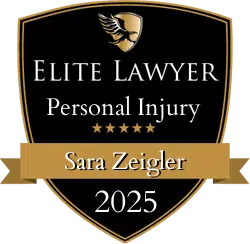When bikers are involved in motorcycle accidents, they are much more likely to sustain injuries far more severe than drivers of passenger cars in similar types of crashes. Motorcyclists do not have the same type of protection as drivers. They are not enclosed in a steel frame, do not have an airbag, or a seat belt. As such, motorcyclists often suffer catastrophic injuries that remain with them for the rest of their lives. Below, one of our West Virginia motorcycle accident lawyers explains the most common motorcycle accident injuries.
Head and Neck Injuries
Under West Virginia law, all motorcycle riders and their passengers are required to wear a motorcycle helmet. Even with a helmet, though, bikers can suffer serious head and neck injuries, including traumatic brain injuries (TBIs). According to a study conducted by the National Highway Traffic Safety Administration (NHTSA), 6.6 percent of motorcyclists who did not wear a helmet suffered a moderate to severe head injury. On the other hand, 5.1 percent of motorcyclists who wore a helmet suffered a serious head injury.
A TBI can occur when the head suffers a direct blow, when the skull and brain are pierced with a sharp object such as glass or metal, or when the brain is violently shaken inside the skull. TBIs are some of the most common motorcycle injuries. They impact a person’s cognitive abilities, physical abilities, and emotions. Some of these injuries can be improved with surgeries and other treatments, but individuals are typically impacted their entire lives by these injuries.
Spinal Cord Injuries
Of all the different parts of the body, the spinal cord is one of the most important, and one of the most sensitive. When it becomes damaged, the results can be catastrophic. These injuries can even be permanent, such as when complete or partial paralysis occurs.
The spinal column is made up of vertebrae that protect the spinal cord. Injuries to the vertebrae can occur when a biker lands on their back or neck, if the motorcyclist becomes crushed between two objects, such as their bike and the ground, or if sharp metal or glass pierces the spinal column.
If the spinal cord is completely severed during a crash, a motorcyclist can be completely paralyzed from the site of the injury and below. If the spinal cord is partially severed, a biker can be partially paralyzed from the site of the injury and below. In either case, there is no cure and bikers will live with the injury for the rest of their lives.
Injuries to the Lower Extremities
A motorcyclist’s legs are completely exposed, and so, injuries to the knees, ankles, legs, and feet are very common motorcycle injuries.
Leg injuries can cause an immense amount of pain and result in expensive medical treatment and long-term disability. Recovering from an injury to the lower extremities can require multiple surgeries, which are invasive and very painful to recover from. These motorcycle accident injuries also require intensive physical therapy for many months. Injured motorcyclists may be left with a limp or even be partially or completely paralyzed, which can impact their quality of life.
Arm Injuries
Arm injuries are also very common motorcycle accident injuries. Torn rotator cuffs are extremely common, and the bones in the arm can also break. The bones in the wrist can also break, particularly if a biker extends their arm to break their fall as they are ejected from their bike.
Road rash is also one of the most common motorcycle injuries. When a biker is thrown from their bike, their skin may scrape along the pavement. This results in a network of scrapes, cuts, and nerve damage. Not only is the initial injury very painful, but it can also cause complications. For example, road rash can become infected, which will extend an accident victim’s recovery.
Multiple Broken Bones
Many parts of a motorcyclist’s body are exposed, and so, they can also become broken during a crash. In the course of an accident, bones in the wrists, arms, and legs can break. Hitting the ground at an awkward angle or with great force can force the body into an unnatural position and break a bone very easily. Broken bones can happen anywhere in the body, but the upper and lower extremities are most vulnerable.
Broken ribs are also common motorcycle injuries, and they pose additional risks. Broken ribs can puncture the lungs they are supposed to protect. Surgery is often required, which involves using pins, rods, and screws to set the ribs. Broken ribs typically require months of rehabilitation.
Internal Injuries
Internal bleeding, punctured organs, and crushed organs are just a few of the most common motorcycle injuries. When a bone is broken during a crash, the bodily organs can be punctured or damaged. This can, in turn, cause internal bleeding. Regardless of whether internal bleeding is in the chest, head, organs, or tissues, it is very dangerous and extremely painful. One reason this motorcycle accident injury is so dangerous is that it cannot be seen, and so, accident victims may not receive the treatment they need. When internal injuries are not treated, they can be fatal.
Psychological Injuries
Not all motorcycle injuries are physical. Psychological trauma can also occur. Accident victims may experience anxiety, nightmares, and even have flashbacks of the crash. After an accident, many bikers are scared to ride again, even when they were ardent enthusiasts before the collision.
Our Motorcycle Accident Lawyer in West Virginia Can Help After Injury
If you or someone you love was injured in a crash, you may have legal options that can help you obtain compensation for your medical expenses, lost income, and other damages. At Kaufman & McPherson, our West Virginia motorcycle accident lawyer will fight for you and your rights to ensure you receive the fair settlement you deserve. Contact us to schedule a free case evaluation with our experienced attorney and to learn more about how we can help with your case.








